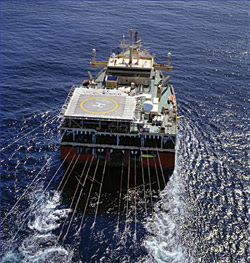Patrick L. Edsell, NP Photonics Inc.
Optoelectronics and fiber optics technology experienced significant advances in the 1990s, driven largely by well-funded innovation in the telecommunications, semiconductor and consumer electronics sectors. Although some of these sectors have since lost momentum, the trickle-down effect for other photonic applications markets has continued and, in some cases, accelerated. Fiber optic sensors, for example, have achieved enhanced performance by integrating improvements in fiber, laser and photodetector technology. At the same time, the relative cost of such devices has come down as a result of advances in optoelectronics manufacturing methods.
In recent years, factors such as escalating demand for increased security, the need for higher-performance military systems and the difficulty in finding new oil reserves have resulted in a demand for better sensing systems. One response to this has been the development of optical fiber sensing technology.

Searching for undersea oil fields in the North Sea, a ship tows an array of fiber optic acoustic sensors. An acoustic transmitter on the ship’s keel beams sound waves downward, and the fiber optic sensors monitor the signal reflected from the ocean floor.
In comparison with conventional sensing technologies, fiber-based sensors are lightweight, compact and easily multiplexed; are resistant to hazardous environments, electromagnetic interference and chemical corrosion; require no electrical power at the sensing point; can distribute sensing over very long distances; and are producible at relatively low cost because of the use of readily available telecommunications components. The result is large, fast-growing opportunities in the security, military, oil and gas, utilities, and research and development markets.
Fiber Bragg gratings (employed with broadband light sources) and distributed sensors based on optical time-domain reflectometry are the most widely used optical sensing technologies today. The recent availability of single-frequency fiber lasers with very narrow linewidths (less than 3 kHz) has enabled a new generation of distributed fiber sensor systems based on optical frequency time-domain reflectometry with frequency scanning, often called frequency-modulated continuous-wave reflectometry. In this technique, the return signals from the various sensors are separated by frequency rather than by time.
The probe laser in this method generates a continuous, frequency-modulated optical wave. These fiber lasers exhibit a coherence length of a few hundred kilometers, frequency stability of better than 10 MHz over long periods, and low phase noise — about two orders of magnitude lower than distributed feedback lasers. This technology provides a new tool for high-performance fiber optic interferometry sensing.
Designers of fiber optic sensing systems based on frequency-modulated continuous-wave reflectometry can take full advantage of these fiber lasers with piezo frequency-modulation capability. In the technique, the reflected optical wave from the sensing fiber is mixed with the laser from the local oscillator, generating a beat frequency, which is called coherent detection. The coherent scheme can detect return signals as small as 10–10 of the probe signal.
Markets
Security/military. Increasing the security of a country’s citizens and assets has become a significant challenge worldwide. Optical sensing solutions allow improved security, with applications including perimeter security for military installations, airports, nuclear power plants and ships; high-resolution perimeter and border security over long distances at reasonable cost; and telecommunications network security. In addition, the military continues to demand higher-performance weapons systems. These include such applications as smart warships and planes, improved threat detection systems in submarines, and improved lidar, nonlethal weapon, rangefinding and mine-detection systems. Improved fiber sensors offer potential solutions.
Oil and gas/utilities. As the price of crude oil continues to rise and difficulties in finding new reserves increase, oil companies have an incentive to increase the output of existing fields. According to industry sources, today’s seismic exploration techniques lead to the extraction of perhaps only 30 percent of the petroleum in a given oil field. Improved exploration techniques, based on optical sensing, are capable of raising that yield to 70 percent. What’s more, the cost of an optical sensing system is much lower than the alternative solutions.
Additionally, optical sensing systems can improve the measurement of pressure and temperature in oil wells and in oil and gas pipelines. There are more than 880,000 oil wells, and 80,000 new wells are drilled every year. Pressure and temperature in these wells is measured with electronic monitoring systems that require power at the sensing point and expensive components, requirements that could be eliminated through the use of fiber sensors.
Moreover, there are more than 2 million miles of oil and gas pipelines in North America and more than 5 million miles worldwide. Inspectors driving or flying along the pipelines monitor conditions almost entirely visually. This is very costly and does not provide the opportunity to identify many potential problems before they occur. A distributed optical sensing system could measure both temperature and strain in more than 100 miles of pipeline in real time, thus identifying both existing and potential problems.
Finally, a market opportunity exists to improve high-voltage power line monitoring. There are approximately 200,000 miles of high-voltage power lines in the US. The Electric Power Research Institute estimates that billions of dollars of electrical capacity is lost every year in the US alone as a result of the inability to accurately measure the strain and temperature on these lines. A distributed optical sensing system could measure temperature within 1 °C and strain within 10–6 in more than 100 miles of power line in real time.
Research and development. Besides the sensing markets, research and development institutes, such as universities and government agencies, are increasingly demanding sources that feature longer coherence lengths and lower phase noise. Universities and research labs require high-power fiber lasers for a variety of applications and across a number of departments, including in electrical engineering, physics, and lasers and optics.
Meet the author
Patrick L. Edsell is president and CEO of NP Photonics Inc. in Tucson, Ariz.; e-mail: [email protected].